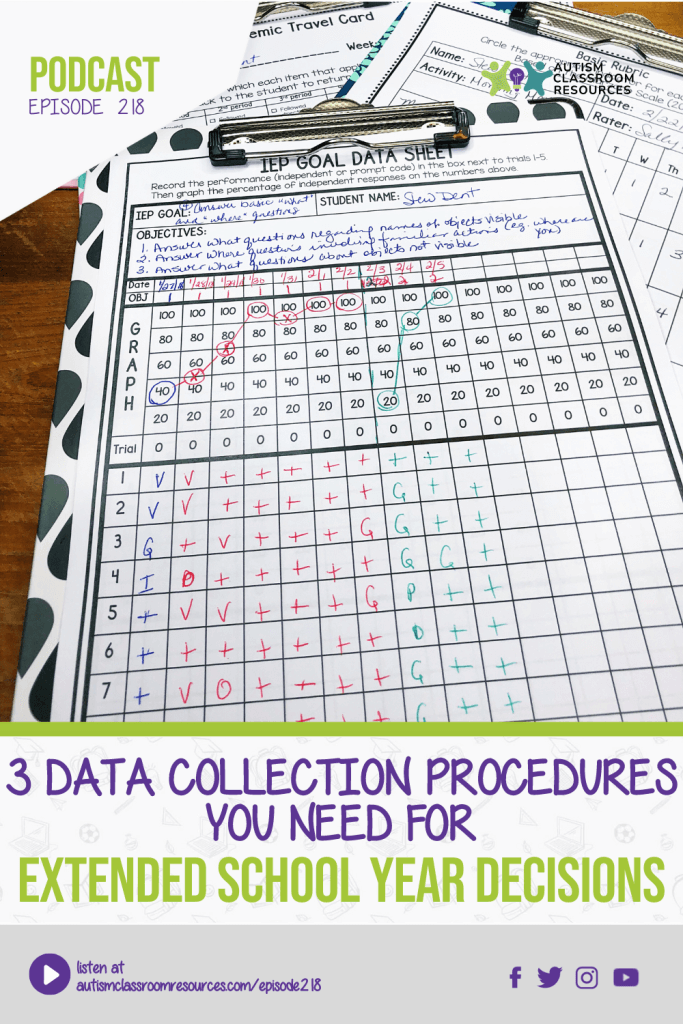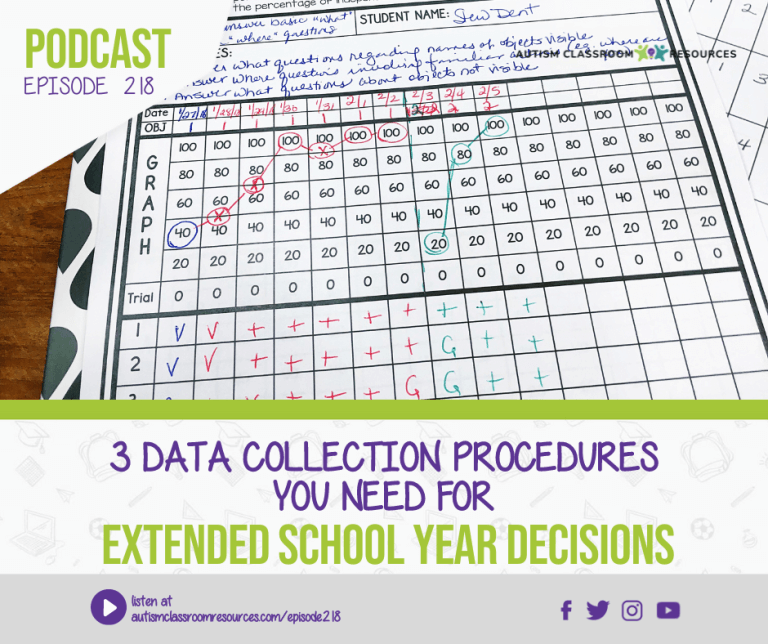Welcome to the Autism Classroom Resources Podcast, the podcast for special educators who are looking for personal and professional development.
Christine Reeve: I’m your host, Dr. Christine Reeve. For more than 20 years, I’ve worn lots of hats in special education but my real love is helping special educators like you. This podcast will give you tips and ways to implement research based practices in a practical way in your classroom, to make your job easier and more effective.
Welcome to the Autism Classroom Resources Podcast. I’m Chris Reeve and I’m your host. And I am hoping that I have caught at least some of you early enough for this episode, in which I’m going to talk about making sure we have what we need for extended school year services.
This is a little later than I had planned to get to it, but things happen. And maybe you’re listening to it when the time that makes sense. So today I want to talk about how to make sure we have data to tell us both about when we need extended school year services for students, but also about making sure that we have data so that we can carry it through extended school year services, especially given that I know most of you who are teaching now may not be teaching ESY, we want to make sure that we have the data for comparison to see how they did. So that that’s going to help us down the line.
So even if you have already made your decisions about ESY for your students, this is an opportunity to make sure you have the data over the summer that you need to help your students be successful. So let’s get started.
For those of you that aren’t as familiar with ESY, ESY stands for extended school year services. There are a lot of state and federal regulations about who qualifies for ESY. But it is typically students who need additional support over a vacation like summer vacation, Christmas vacation, spring vacation, most traditionally over the summer, to make sure that they are not regressing or losing skills that are critical to the student’s development.
And it’s really important to recognize every state is different. There are federal regulations for this. But I have discovered over time that sometimes they don’t always completely match up, sometimes they’re more, they really shouldn’t be less, but they might be and the key is really at looking at the student at looking over the course of a holiday or something like that. So again, if you are listening to this one I’m airing it in May, this may be something that may be helpful to know to take your data at the end of the year to look at whether or not the student regressed when he comes back to school next year.
Oftentimes, we use data over the winter holiday. The problem with that is that there’s a big difference between being out for two weeks and being out for eight weeks, or however long your summertime lasts.
So one of the things that you typically have to show to qualify for ESY is that there has been a regression of skills, and that the student was unable to regain those skills within a reasonable timeframe. So it’s not the only measure that is used, but it is a key one. So taking data during the year does become really important. And I’ve got a free resource that can help you with that as well. So just hold on, and I’ll talk about that at the end. But really making sure that we have our data so we can look at how was he when he left at break and how was he when he came back.
So this doesn’t have to be overwhelming. And it doesn’t have to be taking data every single day. Or it doesn’t have to be you know, taking down every single thing with student does. But you do need a few things. You need to really know what your students skills are that you’re addressing during ESY. And I’ll talk about that in just a minute.
But you can start by assessing whether or not your student regresses from the beginning of break to the end of break by using your curriculum assessments. And curriculum assessments, or curriculum based assessments are things like if you’re using the Unique Learning System, or you’re using the protocol for the strategies for teaching based on autism research, or the ABLLs, or the VB MAPP, or if you’re working with young kids using the Brigance. Those are things that if we take assessment snapshots at the beginning of the year, at the middle of the year, maybe when they come back from winter break, and at the end of the year.
We can use those to assess the student to see if they are making progress or if they are not. If they’ve lost skills from when they left for break versus when it came back. So those are really good ways and I’ll put links to those if you’re not familiar with them in the show notes as well. But I do this three to four times a year. and it really helps to have one at the end of the year before the student goes into summer. Because that’s going to allow you to really look at how he is when he comes back, especially if he didn’t qualify for ESY this year, or if he did, if he maintained his skills. If he didn’t, he may need more ESY. If he made a lot of progress, then maybe he didn’t need as much ESY. So it depends on how your district does that.
During ESY you want to think about taking weekly data during ESY. So ESY’s focus is typically on either maintaining skills, and preventing regression, or maintaining progress towards a critical life skill. So you want to make sure that you have clearly defined what your targeted skills are for ESY.
Most of you probably work in districts where they identify specific goals that you need to work on during ESY. Now, there are going to be lots of other things that we may work on during that time that are folded into our summer curriculum. But you know, for some of our kids, we might be focusing on the whole IEP, but for some we may have pulled specific goals out to focus on.
Either way, rather than trying to take data on every single thing, focus on those things that you’re trying to track for ESY and do a weekly assessment. So unless you’re working on something that the student is currently really struggling with, then weekly data is going to be enough. Now if you have a student who is really struggling, for instance, with reading, you’re going to need more frequent assessments of reading than just once a week, because he’s really struggling to keep those skills or learn new skills, if that’s part of the goal.
But if you’re just monitoring ongoing skills, weekly data should do okay. Again, if you see your students start to regress, you may need more data to make sure that you can problem solve so that you can prevent that regression. Just because it’s ESY doesn’t mean that we don’t try to make sure that we’re keeping what we’re working on.
Typically weekly data is going to be fine. So I use the naturalistic data sheet. And I’ve got a tutorial in my TPT store on taking sample data. And I will link that in the show notes. There’s a free video and you can download the sheet there for free. But it focuses on either tracking one student across activities, or multiple students in one activity. And it can be used different ways. But that data sheet is really useful, because it allows you to get that one weekly sample. You can also find the naturalistic data sheet in my pack of intervention, instructional data sheets on TPT. And I will link those in the show notes as well.
And finally, one of the biggest things that we have to make sure that we do is make sure that you have solid data at the end of ESY to start the year. And if you’re the teacher, you want to make sure that that data moves with the student. This data allows us to determine, did they have the skill at the end of ESY and maybe there was a four week break before we came back to school. And maybe we lost it. So that’s also going to be good data moving forward.
If the student is moving on to a different teacher, if you weren’t the one teaching ESY, ask about that ESY data. You want that data, just like I want the data from the school year to go to ESY, I want the data from ESY to come back to the school. That way you’re going to know as the teacher what skills the student lost between the end of ESY and the school year, and then you can pull that data out to make the decision for next year.
So if you are teaching is why this year, thank you so much. I know that it is a crazy enough year without everything else. But our students really do need that support many times in that summer programming. So thank you so much for what you’re doing. Not that there’s a problem if you’re taking the summer off, you need to do that as well.
If you’re looking for more ideas about setting up a data collection system in the classroom in general, without driving yourself crazy, then you can check out our free webinar on setting up data collection systems. And you can find that at autismclassroomresources.com/data. I will also put links to my data sheets, as well as the free tutorial on TPT for taking data. And the webinar for setting up data collection systems is free as well. So you can find all of that.
If you are interested in a deep dive in data over the summer or anytime, come and join us in the Special Educator Academy. We have a whole course that is broken down into 15-20 minutes components along with data sheets that come with the course to really create a good system of data for your classroom based on your students needs. And if you have questions as you go along, I am always available in our community and in our private Facebook group. So you can find more information about the Special Educator Academy at autismclassroomresources.com/SEA.
Thank you so much for joining me. I hope that you are having a wonderful end to the school year. I am going to take a break for a little bit and so we’re going to share some best of podcasts over the next few weeks. And hopefully you will enjoy them and find some that you maybe have not listened to before. And I hope to see you again later this summer.
Thanks so much for listening to today’s episode of the Autism Classroom Resources podcast. For even more support, you can access free materials, webinars and Video Tips inside my free resource library. Sign up at autismclassroomresources.com/free. That’s F-R-E-E or click the link in the show notes to join the free library today. I’ll catch you again next week.









